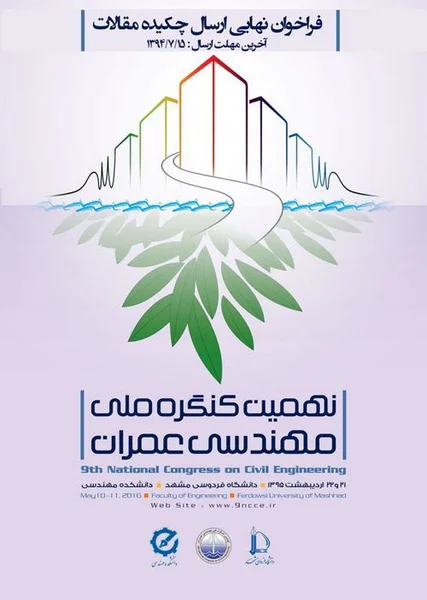-
an innovative proposal on selection of initial guess in pipe network analysis with due consideration on network topology
جزئیات بیشتر مقاله- تاریخ ارائه: 1395/01/01
- تاریخ انتشار در تی پی بین: 1395/01/01
- تعداد بازدید: 496
- تعداد پرسش و پاسخ ها: 0
- شماره تماس دبیرخانه رویداد: -
simulation of fluid flow in pipe network distribution systems is considered to be a classic engineering problem in fluid mechanics and hydraulic engineering. as a general rule, the analysis and simulation is intended to provide velocity and pressure fields. the corresponding fields would provide the required data to design a variety of networks including water network distribution, drip irrigation network, oil distribution and ventilation facilities, etc. the basic hydraulic equations for analyzing such networks are continuity and energy equations leading into a system of nonlinear simultaneous algebraic equations in terms of discharge in each pipe or hydraulic head at each node and/or discharge correction in each loop. the resulting system is nonlinear and demands for intelligent selection of initial guess. the current literature on appropriate selection of initial guess is quite vague and does not consider the overall configuration of network including its topology (i.e., pipe length and diameter), topographic variations, etc. in the current paper, it is hypothesized that wise and logical selection of initial guess with due consideration on network topology and topographic variations (particularly for large networks) will enhance the convergence rate and reduce the number of iterations required to reach the final steady state solution. for this purpose, at the start of simulation, the flow regime is considered to be laminar which will result in linear relationship between velocity and pressure fields. incorporation of this assumption leads to a system of linear simultaneous algebraic equations which obviously does not require any initial guess and will take into account network topology and topographic variations. finite element method is used to cast and solve the resulting system associated with laminar flow regime assumption. the resulting solution for hydraulic head at each node and discharge in each pipe is utilized to derive the network when the follow regime is turbulent. the efficiency and the rate of convergence of the proposed suggestion concerning initial guess is compared and contrasted with conventional guesses proposed in the current literature. results obtained from this study provided the least number of iterations and cpu time for some version of the proposal compared to other conventional guesses cited in the literature. in conclusion, it is suggested that the available commercial and public domain software be equipped with this proposal for routine application.
مقالات جدیدترین رویدادها
-
استفاده از تحلیل اهمیت-عملکرد در ارائه الگوی مدیریت خلاقیت سازمانی و ارائه راهکار جهت بهبود
-
بررسی تاثیر ارزش وجوه نقد مازاد بر ساختار سرمایه شرکت های پذیرفته شده در بورس اوراق بهادار تهران
-
بررسی تأثیر سطح افشای ریسک بر قرارداد بدهی شرکت های پذیرفته شده در بورس اوراق بهادار تهران
-
بررسی تأثیر رتبه بندی اعتباری مبتنی بر مدل امتیاز بازار نوظهور بر نقد شوندگی سهام با تأکید بر خصوصی سازی شرکت ها
-
تأثیر آمیخته بازاریابی پوشاک ایرانی بر تصویر ذهنی مشتری پوشاک ایرانی (هاکوپیان)
-
ارزیابی الگوی قرارگیری مهاربندهای زانویی بر پاسخ سازه فولادی
-
بررسی مفاهیم پایداری و تحلیل آن در ساختمان های سبز
-
شبیه سازی عددی جریان توام و آرام و انتقال حرارت سیال در مجرا با انبساط ناگهانی
-
تعیین آزمایشگاهی ضریب دبی سرریز فیوزگیت قبل از واژگونی با افزایش جرم وزنه
-
(applied modeling of computational fluid dynamic for eco-lab concentration changes with sediment transport (case study shadegan lake
مقالات جدیدترین ژورنال ها
-
مدیریت و بررسی افسردگی دانش آموزان دختر مقطع متوسطه دوم در دروان کرونا در شهرستان دزفول
-
مدیریت و بررسی خرد سیاسی در اندیشه ی فردوسی در ادب ایران
-
واکاوی و مدیریت توصیفی قلمدان(جاکلیدی)ضریح در موزه آستان قدس رضوی
-
بررسی تاثیر خلاقیت، دانش و انگیزه کارکنان بر پیشنهادات نوآورانه کارکنان ( مورد مطالعه: هتل های 3 و 4 ستاره استان کرمان)
-
بررسی تاثیر کیفیت سیستم های اطلاعاتی بر تصمیم گیری موفق در شرکتهای تولیدی استان اصفهان (مورد مطالعه: مدیران شرکتهای تولیدی استان اصفهان)
-
بررسی یادگیری مشارکتی دانش آموزان
-
بهینه سازی تخلیه ساکنین در برج های بلند در شرایط اضطراری، با استفاده از پل های هوایی بین برج ها
-
نقش ویژگی های شخصیتی در پیش بینی ابراز هیجان خودآگاه و بازشناسی هیجانات چهره در دانش آموزان
-
iranian eocene green tuffs as natural pozzolan for use in cement industries
-
effect of corrugation angle and direction on the performance of corrugated steel plate shear walls




سوال خود را در مورد این مقاله مطرح نمایید :